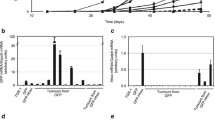Abstract
Induction of the transcription factor Myc promotes cell proliferation and transformation by activating growth-promoting genes and/or by transcriptionally repressing the expression of growth arrest genes. However, a number of studies have shown that c-Myc is a potent inducer of apoptosis in the absence of serum or growth factors. To further examine the role of Myc in cell growth and proliferation, and the advantages of this positive regulator in cell culture we transfected the CHO-K1 cell line with a human c-myc gene driven by MMLV 5′-LTR promoter. Over-expression of ectopic c-Myc resulted in a significant increase in growth rate and maximum cell number, in both suspension and attached batch culture accompanied by a similar decrease in specific glucose consumption rate. Interestingly, there was no manifestation of the widely reported apoptotic death by c-myc in the absence of serum. Additionally, over-expression of c-Myc appeared to induce morphological transformation and partial anchorage-independence.
Similar content being viewed by others
References
Al-Rubeai M., Singh R.P., Goldaman M.H. and Emery A.N. 1995. The death mechanism of animal cells in conditions of intensive agitation. Biotech Bioeng 45: 463–472.
Al-Rubeai M. 1998. Apoptosis and cell culture technology. In: Scheper T. (ed.), Advances in Biochemical Engineering/Biotechnology Vol. 59. Springer-Verlag, pp. 226–249.
Amati B., Littlewood T.D., Evan G.I. and Land H. 1993. The c-Myc protein induces cell cycle progression and apoptosis through dimerization with Max. EMBO J 13: 5083–5087.
Bissonnette R.P., Echeverri F., Mahboubi A. and Green D.R. 1992. Apoptotic cell death induced by c-myc is inhibited by bcl-2. Nature 359: 552–554.
Bouchard C., Staller P. and Eilers M. 1998. Control of cell proliferation by Myc. Trends Cell Biol 8: 202–206.
Claasen G.F. and Hann S.R. 1999. Myc mediated transformation: the repression connection. Oncogene 18: 2925–2933.
Cole M.D. 1986. The myc oncogenes: its role in transformation and differentiation. Ann Rev Genet 20: 361–384.
Evan G.I., Wyllie A.H., Gilbert C.S., Littlewood T.D., Land H., Brooks M. et al. 1992. Induction of apoptosis in fibroblasts by c-Myc protein. Cell 69: 119–128.
Evan G.I., Harrington E., McCarthy N., Gilbert C., Benedict M.A. and Nuñez G. 1996. Integrated control of cell proliferation and apoptosis by oncogenes. In: Thomas N.S.B. (ed.), Apoptosis and Cell Cycle Control in Cancer. BIOS Scientific Publishers, Oxford, pp. 109–129.
Facchini L.M. and Penn L.Z. 1998. The molecular role of Myc in growth and transformation: recent discoveries lead to new insights. FASEB J 12: 633–651.
Fanidi A., Harrington E.A. and Evan G.I. 1992. cooperative interaction between c-myc and bcl-2 proto-oncogenes. Nature 359: 554–556.
Fussenegger M. and Bailey J.E. 1998. Molecular regulation of cell-cycle progression and apoptosis in mammalian cells: implications for biotechnology. Biotechnol Prog 14: 807–833.
Hoffman B. and Liebermann D.A. 1998. The proto-oncogene c-myc and apoptosis. Oncogene 17: 3351–3357.
Marcu K.B., Bossonne S.A. and Patel A.J. 1992. Myc function and regulation. Annu Rev Biochem 61: 809–860.
Meichle A., Philipp A. and Eilers M. 1992. The functions of Myc proteins. Biochem Biophys Acta 1114: 129–146.
Penn L.J.Z., Brooks M.W., Laufer E.M. and Land H. 1990. Negative autoregulation of c-myc transcription. EMBO J 9: 1113–1121.
Prendergast G.C. 1999. Mechanisms of apoptosis by c-Myc. Oncogene 18: 2967–2987.
Sanfeliou A. and Stephanopoulos G. 1999. Effect of glutamine limitation on the death of attached Chinese hamster ovary cells. Biotech Bioeng 64: 46–53.
Simpson N.A., Milner E. and Al-Rubeai M. 1997. Prevention of hybridoma cell death by bcl-2 during sub-optimal culture conditions. Biotech Bioeng 54: 1–16.
Small M.B., Hay N., Schwab M. and Bishop M. 1987. Neoplastic transformation by the human gene N-myc. Mol Cell Biol 7: 1638–1645.
Spencer C.A. and Groudine M. 1991. Control of c-myc regulation in normal and neoplastic cells. Adv Cancer Res 56: 1–48.
Wahgner A.J., Small M.B. and Hay N. 1993. Myc-mediated apoptosis is blocked by ectopic expression of Bcl-2. Mol Cell Biol 13: 2432–2440.
Author information
Authors and Affiliations
Rights and permissions
About this article
Cite this article
Ifandi, V., Al-Rubeai, M. Stable transfection of CHO cells with the c-myc gene results in increased proliferation rates, reduces serum dependency, and induces anchorage independence. Cytotechnology 41, 1–10 (2003). https://doi.org/10.1023/A:1024203518501
Issue Date:
DOI: https://doi.org/10.1023/A:1024203518501




